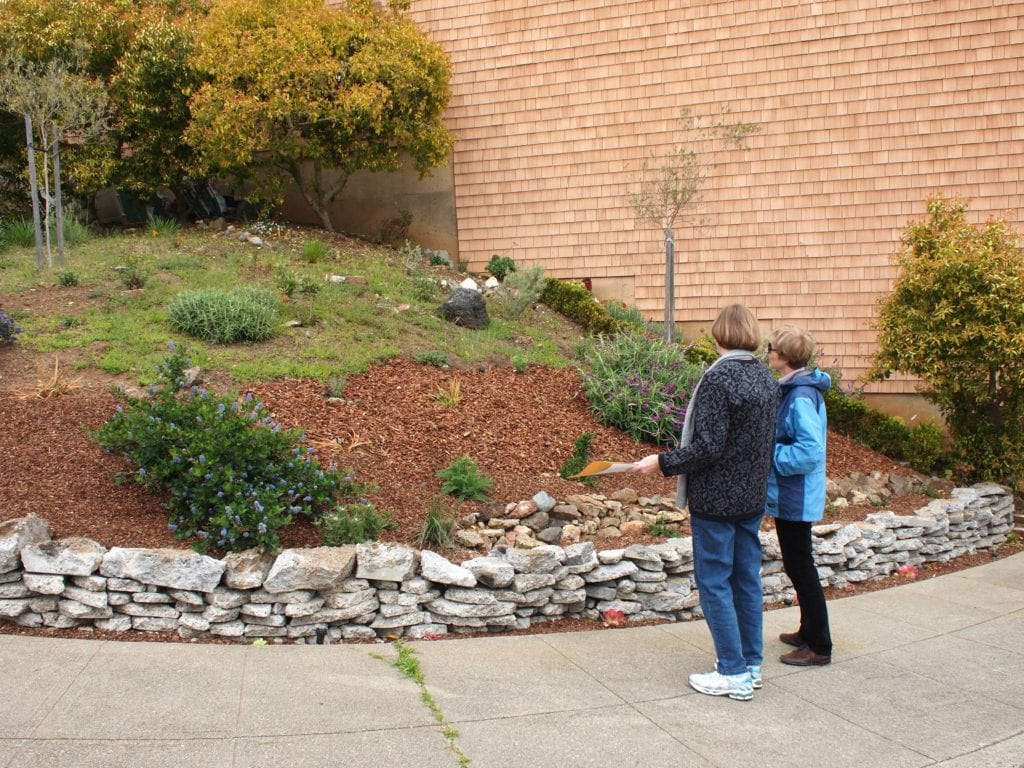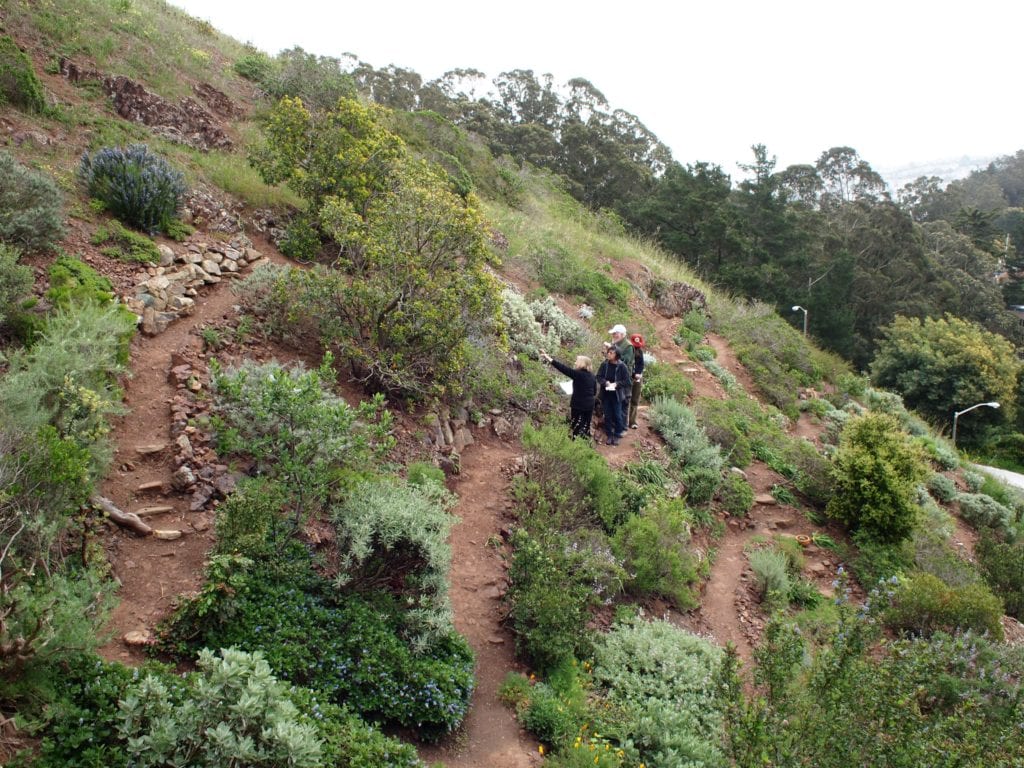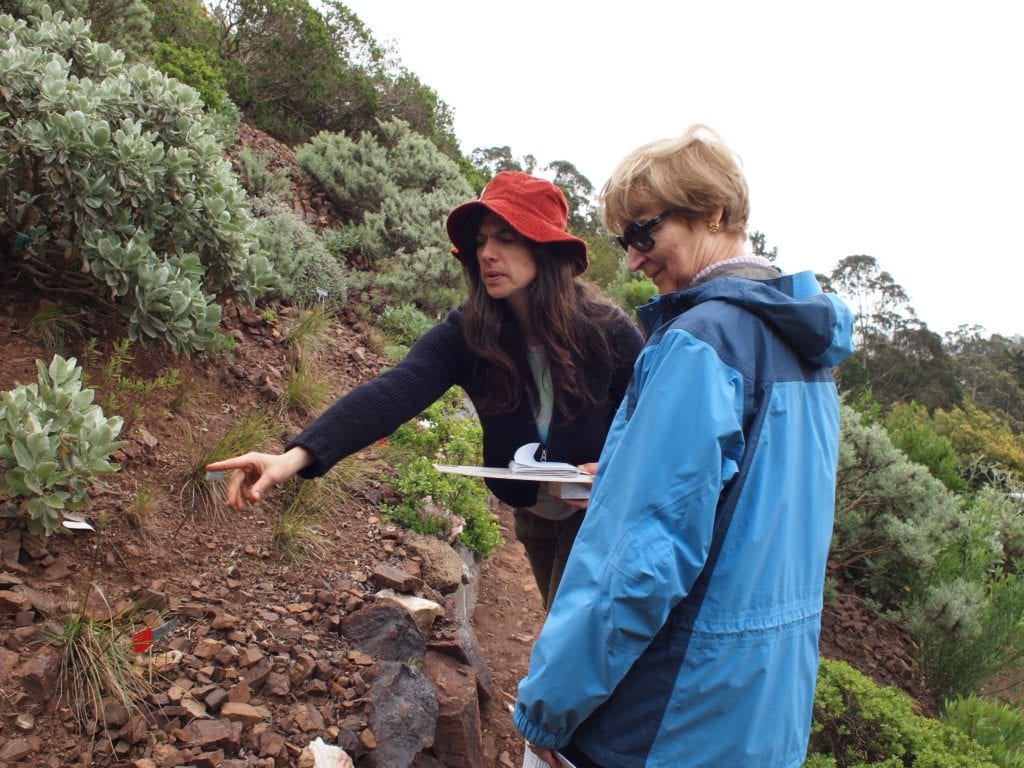
Photo by Murray Schneider.
By Murray Schneider
Along Glen Canyon’s Islais Creek, not far from Silver Tree Day Camp, one can pass native columbine and sticky monkey flower, both plants native to California. A little farther west, across O’Shaughnessy Boulevard, half way between Glen Park’s village and School of the Arts, similar natives hug a craggy hillside left intact when Depression-era construction workers dynamited chert outcroppings to chisel a swath of road named after City civil engineer Michael O’Shaughnessy.
As a red tailed hawk circles, it’s only a football field length or two or three from Islais Creek to Valletta Court and Malta Drive, the base camp for a promontory that boasts proliferations of California natives, only rivaled in numbers by what one might experience in the San Francisco Botanical Garden.
Here, coyote brush, California blackberry, Douglas iris, ceanothus, even Yerba Buena, a plant for which San Francisco was named, bloom. Each was on colorful display April 15th, part of 19 native plant garden tours sponsored by the Yerba Buena chapter of the California Native Plant Society.

Photo by Murray Schneider
Georgia Fie lives on Valletta Court with her husband Gary. After being chained to her desk for 35 years, the outdoors beckoned.
Gardening was just her ticket.
“About two years ago I saw my neighbor Jeanne’s garden and how beautiful it was,” said Fie, who lives at 4 Valletta Court and whose back yard garden is visible from the street, “so I hired landscape designer Alma Hecht to design it.”
Two years later Fie’s garden is now a parabola of red buckwheat, bee plant and pink flowering currant.
“I’ve added a few plants to Alma’s design,” admitted Fie, with modest understatement. “I couldn’t resist.”
Throughout the day, Fie gave shout outs to her plants, each one enjoyed by 40 visitors who took her Sunday tour and who marveled at what she’d accomplished in such a short period.
“I have about 12 species of natives now,” Fie said. “In the spring the ceanothus is always irresistible and the bees love it. It’s so easy to grow. But the Douglas iris is beautiful, too.”

Photo by Murray Schneider
Jeanne Koelling sat at a table at the rear of Fie’s garden, handing out CNPS literature, requesting attendees sign in. The 44 O’Shaughnessy chugged up the hill, but even its elephantine cumbersomeness couldn’t detract from the delicate beauty of a petite garden that attracted hovering and pollinating bumblebees.
“The Yerba Buena is really nice, really lush,” Koelling said, as she distributed copies of the Yerba Buena News, the native plant society’s newsletter.
Fie, who volunteers each Wednesday with the Friends of Glen Canyon Park and is one of the 27 home delivery carriers for the Glen Park News (when she isn’t finding time to quilt), doesn’t underestimate the effect her green thumb has on her environs.
“I get lots of compliments from the neighbors and people driving by,” she said. “I think providing something beautiful for people to enjoy for the moment is worth the effort.”
She pointed to some rosemary hanging over a wall.
“Sometimes people stroke it when they walk by and then smell it,” she said. “A garden can please the senses.”
Nursing a cup of steaming herb tea, Jeanne Halpern, who served as Fie’s Valletta Court horticultural mentor, agrees with her neighbor.
Halpern was pleased 72 visitors attended her garden tour, an all time record.
“This is the most successful tour ever,” she said. “It drew in people from the other neighborhoods and even from the peninsula.”
Halpern enlisted four people to serve as guides and drafted assistants to sign in guests and hand out materials.
“Hal and Susan Tauber were delighted to know where their soil goes,” Halpern joked, referring to the owners of Glen Park Hardware.
“Jeanne’s created an amazing space,” said Hal Tauber. “It’s like a state park restoration, so beautifully tended and using the natural ecology so well.”
“It’s a beautiful garden,” agreed Susan, “making such good use of the cliff.”
Halpern enrolls the expertise of Marina Lazzara from Rhythm Gardens to help maintain her garden, which was designed by author Alrie Middlesbrook and naturalist David Schooley.
Her garden boasts 18 native plants, which have survived on her site for eons.
Early on Sunday morning, a trail of visitors, scribbling notes and walking gingerly because the trails were both narrow and steep, followed Halpern along paths sculpted from red chert, paths that might have challenged the surefootedness of cliff dwelling Anasazi native-Americans.
Marina Lazzara, who devotes several hours a week helping to maintain Halpern’s garden, guided another group visitors around serpentining paths.
Below Lazzara, Halpern pointed to some purple needle grass, the California state grass.
“I collected seeds in different parts of the garden years ago, and after Licia DeMeo germinated them,” Halpern said, “we both planted them on our hands and knees on the hillside.”
Red flags peaked from beneath carpets of grasses and plants.
“Each flag signifies these grasses and plants are ‘native native’,” she said. “They probably been on this hillside before Indian time.”
Anyone interested in learning more about beginning his or her own native plant garden can obtain more information from Alma Hecht at http://secondnature.bz/. or rhythmgardens@gmail.com, or California Native Plant Society at www.cnps.org (916-447-2677).